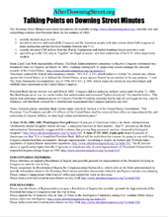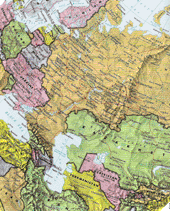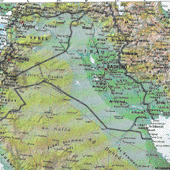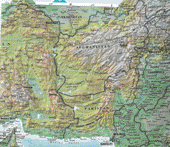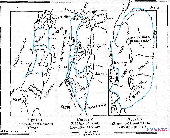|
|||||||||
|
|
Search Engines
![]() ask Jeeves
ask Jeeves ![]() Google.com
Google.com
![]() Mama.com
Mama.com ![]() Excite
Excite
![]() AOL Netfind
AOL Netfind ![]() Lycos
Lycos
![]() Webcrawler
Webcrawler ![]() Yahoo
Yahoo
![]() technorati (searches blogs)
technorati (searches blogs)
Tip: Some search engines like Google give preference to pages containing Google ads, frustrating search results for scholars.
|
Metric Conversion kilometer: 0.6214 mile |
|
New paper that could lead to the impeachment of President George W. Bush. Click on image for pdf. file download. |
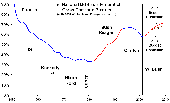 |
|
Federal Debt vs GDP– Click image for larger view. (OMB) |
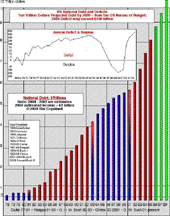 |
|
Chart showing National Debt & Annual Deficits with Presidents. Democrat administrations are blue, Republican in Red. Green reflects projected Bush debt. Click chart for larger image. |
 |
|
Interest exceeds Group A outlays. Click chart for larger image. |
| Gross Domestic Products. Click here for image. |
![]() Worth frequent visits
Worth frequent visits
Skippy the Kangeroo
grumpy old man (PG-18)
Democratic Underground
Altercation
American Politics Journal
American Progress Report
Americablog
Earth-Info.net
Aral Sea Disaster
oilonline.com
Media Matters
Take Back the Media
Greg Palast
afterdowningstreet.org
Big Brass Alliance
DOD News
The New Yorker magazine
Halliburton watch.org
First Read (MSNBC)
GLOBEANDMAII.COM
liberation.fr (en français)
lefigaro.fr (en français)
Spiegel Online
La Repubblica.It
Arch. & Prehistory news
New Scientist
National Public Radio
![]()
![]()
![]()
![]()
ABC News
Fox News
![]()
CNN
![]()
![]()
Financial Times
Bloomberg.com
Sky News (London)
timesonline.uk (London)
![]()
The Independent
![]()
![]()
telegraph.co.uk
DW-World.DE
NIS News (Holland)
Belfast Telegraph
Radio Free Europe
Radio News America
AFP
![]()
![]()
![]()
![]()
Detroit Free Press (Freep)
![]()
![]()

International Agencies – News
This monster's own words will
lead to his destruction
Definition of fatwa (fatwah)
Maravot News Comment
12.17.04
10.29.04
2.23.98
August 1996
Maps of interest
![]() TurkishPress.com
TurkishPress.com
![]()
![]() Al-jazeera
Al-jazeera
![]()
kurdistanobserver
![]()
Iraq the Model (Blog)
Azzaman.com (Iraq)
Iran Focus
Iran Daily
Iranmania.com
![]()
Middle East Newsline
![]() Jerusalem Post
Jerusalem Post
![]()
![]() Haaretz Daily
Haaretz Daily
![]()
pmwatch.org
Palestine Chronicle
![]() Daily Star (Lebanon)
Daily Star (Lebanon)
![]()
topix.net (Qatar)
Saudi Post
Yemen Daily
![]() Khaleej Times (Yemen)
Khaleej Times (Yemen)
tajikistannews.net/
Khabar.kz
Russia & Ukraine Watch
East Asia Watch
![]() Jang.com.pk
Jang.com.pk
![]()
Dawn
Daily Times,com. pk
South Asia Tribune
asianage.com
![]() India Express
India Express
![]()
Indo-Asian News Service
New Kerala (India)
![]()
Hindustan Times
![]()
xinhuanet (China)
![]()
Asia Times (Hong Kong)
asianewsnet.net
![]() China Daily
China Daily
![]()
Shenzhen Daily
CRI online (China)
Big News Network
![]() Korea Herald
Korea Herald
![]()
Kyodo News
![]()
Japan Times
![]() Japan Today
Japan Today
![]()
Daily Yomiuri (Japan)
![]() The Star (Malaysia
The Star (Malaysia
![]()
![]() The Jakarta Post
The Jakarta Post
![]()
Bangkok Post
![]()
The Nation (Bangkok)
Kashmir Times
Press Trust of India
![]()
Daily News (Sri Lanka)
LankaPage (Sri Lanka)
inq7.net (Phillipines)
![]() news.com.au
news.com.au
![]()
theaustralian.news.com.au
![]()
![]()
![]()
![]()
![]()
because of me, Dec. 1993
content of any links
from this site.
|
|
On Liberty, J. S Mill
Works of Josephus
Juvenal, Sixteen Satires
Bible Concordance
Koran
Links to Biblical documents
Joinville & Villechardouin,
Chronicles of the Crusades
Polybius
Plutarch's "Lives"
Tacitus
Lives of the 12 Caesars
Meditations, M. Aurelius
Memorabilia (Xenophon)
The Offices (Cicero)
Leviathan (Hobbes)
The Secret History
(Procopius)
Herodotus
maravot,
links & works
![]()
![]()
![]()
![]()
![]()
![]()
![]()
![]()
![]()
![]()
![]()
![]()
![]()
![]()
News Headlines & Trends – Page 2
09.17.05 US oil supply damage due to Hurricane Ivan (2003) and Hurricanes Katrina and Rita (TBD) and related damage (continued)
According to eia.doe.gov, the list below contains imports of crude oil in the US by ranking (We show 17 of those listed). Some oil production data as of 1 January 2005 according to the Department of Energy is as follows:
According to the Oil and Gas Journal, the United States had 21.9 billion barrels of proved oil reserves as of January 1, 2005, eleventh highest in the world.
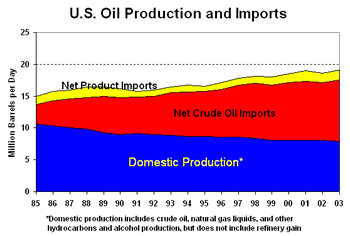 |
|
Chart from eia.doe.gov
|
US crude oil production, which declined following the oil price collapse of late 1985/early 1986, leveled off in the mid-1990s, and began falling again following the sharp decline in oil prices of late 1997/early 1998. During 2003, the United States produced around 7.8 million barrels per day (bbl/d) of oil, of which 5.7 million bbl/d was crude oil, and the rest natural gas liquids and other liquids. U.S. total oil production in 2003 declined sharply (around 2.8 million bbl/d, or 26%) from the 10.6 million bbl/d averaged in 1985. U.S. crude production, which averaged 5.4 million bbl/d during the first ten months of 2004, is now at 50-year lows.
The United States contains over 500,000 producing oil wells, the vast majority of which are considered "marginal" or "stripper" wells, generally producing only a few barrels per day of oil. During 2003, top oil producing areas included the Gulf of Mexico (1.6 million bbl/d), Texas onshore (1.1 million bbl/d), Alaska's North Slope (949,000 bbl/d), California (683,000 bbl/d), Louisiana onshore (244,000 bbl/d), Oklahoma (178,000 bbl/d), and Wyoming (143,000 bbl/d).
| Rank | Country of Origin | Thousand Barrels/day |
| 1 | Canada | 1,616 |
| 2 | Mexico | 1,598 |
| 3 | Saudi Arabia | 1,495 |
| 4 | Venezuela | 1,297 |
| 5 | Nigeria | 1,078 |
| 6 | Iraq | 655 |
| 7 | Angola | 306 |
| 8 | Kuwait | 241 |
| 9 | United Kingdom | 238 |
| 10 | Ecuador | 232 |
| 11 | Algeria | 215 |
| 12 | Russia | 158 |
| 13 | Norway | 143 |
| 14 | Colombia | 142 |
| 15 | Gabon | 142 |
| 16 | Argentina | 59 |
| 17 | Brazil | 51 |
| – | Total | 10,088 |
| – | Persian Gulf |
2,400 |
Meanwhile, Alaskan oil production is expected to decrease by 5% in 2004 and by 1% in 2005, continuing a steady decline since the state's peak output in 1988, at 2.017 million bbl/d. For the period January-August 2004, Alaska averaged production of about 902,000 bbl/d of oil, or about 16% of total U.S. crude oil production. Most of Alaska's oil output comes from the giant Prudhoe Bay Field, and is transported via the Alyeska pipeline. A new oilfield, known as Alpine (owned 78% by Phillips Petroleum, 22% by Anadarko), began production in November 2000. Alpine represents one of the largest North American onshore oil discoveries in years, and currently is producing around 100,000 bbl/d of high quality, light crude oil. Production at Alpine is to be maintained using tie-ins to the Nanuq and Fiord satellite fields beginning in 2006. Phillips has been the largest oil producer in Alaska since acquiring Arco's Alaska fields in early 2000. The combined production rate from the Alpine and North Star fields averaged nearly 173,000 bbl/d during June 2003. Production from the Kuparuk River field plus the production from West Sak, Tobasco, Tarn and Meltwater fields is expected to produce an average of 210,000 bbl/d in coming years.
In early 2000, the Energy Information Administration (EIA), in response to a Congressional request, issued a report on potential oil reserves and production from the Arctic National Wildlife Refuge (ANWR). The report, which cited a 1998 U.S. Geological Survey study of ANWR oil resources, projected that for the mean resource case (10.3 billion barrels technically recoverable), ANWR peak production rates could range from 1.0 to 1.35 million bbl/d, with initial ANWR production possibly beginning around 2010, and peak production 20-30 years after that.
In recent years, production from deepwater areas of the Gulf of Mexico has been increasing rapidly, with deepwater wells now accounting for about two-thirds of total U.S. Gulf output. Large fields include ExxonMobil's $1.1 billion Hoover-Diana development (which started up in May 2000 and was producing 80,000 bbl/d by 2002), plus several by BP: 1) the $2.5 billion Atlantis project, scheduled to come online in the third quarter of 2006, with 150,000 bbl/d of peak oil production capacity; 2) the 1-billion-barrel Thunder Horse (previously "Crazy Horse") field, the largest single field ever discovered in the Gulf of Mexico, scheduled to come online in 2005 with 250,000 bbl/d of peak oil output; 3) Crosby (developed by Shell, came online in late 2001, peak output of 60,000 bbl/d); 4) Holstein (BP; expected online by the end of 2004); 5) King (BP); 6) King's Peak (BP); 7) Mad Dog (BHP Billiton; expected online by early 2005); 8) Marlin; and 9) Nakika (Shell and BP; first production in December 2003; ramping up to 110,000 bbl/d) fields. For its part, BP has stated that it plans to accelerate its deepwater Gulf of Mexico production plans, including the planned $1 billion "Mardi Gras" deep-sea pipeline system, designed to transport more than 1 million bbl/d of oil.
In June 2003, Unocal announced its intentions to build a $500 million deepwater crude oil port, the Bulk Oil Offshore Transfer System (BOOTS) in the Gulf of Mexico 100 miles south of Beaumont, TX. The BOOTS system would have a capacity of 1.2 million bbl/d, and would be linked to refineries in Houston/Texas City, Beaumont/Port Arthur, and Lake Charles. As of October 2004, however, Unocal had placed BOOTS development on hold "pending receipt of sufficient volume commitments from crude oil import shippers."
Petroleum Imports/Exports
The United States averaged total net oil (crude and products) imports of an estimated 11.8 million bbl/d during January-October 2004, representing around 58% of total U.S. oil demand. Crude oil imports from Persian Gulf sources averaged 2.4 million bbl/d during that period.
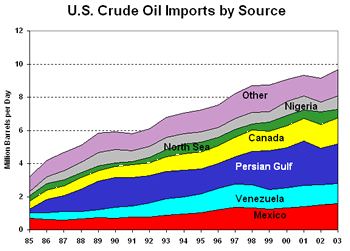 |
This was the situation before Hurricane Katrina. The latest information is provided by ogj.pennet.com Market Watch article, "Energy prices fall as OPEC pledges spare capacity."
HOUSTON, September 21 – Energy prices retreated Sept. 20 but kept most of the gains from record spikes in the previous session as the Organization of Petroleum Exporting Countries promised, if necessary, to release its remaining 2 million b/d of spare production capacity for a period of 3 months, starting Oct. 1.
Many analysts and political leaders outside of OPEC had expected the cartel to hike production by 500,000 b/d to 28.5 million b/d at its meeting in Vienna. OPEC production currently is estimated at 28.3 million b/d. Including Iraqi production, OPEC output is 30.2 million b/d.
Some observers said OPEC's alternative action effectively suspends its current production quota of 28 million b/d for only the second time in the group's history. The first occurred in 1990 when Iraq invaded Kuwait.
Saudi Arabia is the OPEC member with the spare production capacity, which is primarily sour crude with a high sulfur content that cannot be processed by many refiners. Recent efforts by both Saudi Arabia and the US Department of Energy to market sour crude found few buyers.
Still, DOE approved Sept. 20 a seventh loan request for crude from the Strategic Petroleum Reserve—600,000 bbl of sour crude for Total Petrochemicals USA Inc. Under that program so far, DOE has distributed 13.2 million bbl of mostly sweet crude out of SPR.
Storm damage
Industry experts claim that it's not more crude that is needed but more refining capacity to process the crude already available. Four Gulf Coast refineries with a combined capacity of 900,000 b/d—Chevron Corp. in Pascagoula, Miss.; ConocoPhillips, Belle Chasse, La.; ExxonMobil Corp., Chalmette, La; and Murphy Oil Corp., Meraux, La.—were disabled by Hurricane Katrina. Now Hurricane Rita is gathering strength in the Gulf of Mexico and is expected to come ashore later this week near Houston, the center of another major concentration of refineries.
Refineries in the Houston area continued normal operations Sept. 21 even as workers began securing those facilities and implementing plans for systematic shutdowns before the storm makes landfall.
The Texas Gulf Coast has four concentrations of refineries with capacities totaling 4 million b/d, about 23% of total US refining capacity. There are four refineries in the Beaumont-Port Arthur area with combined capacity of 1 million b/d, six in and around Houston with 1.6 million b/d, three in Texas City with 740,000 b/d, and four in Corpus Christi with 690,000 b/d.
Early on Sept. 21, Rita strengthened into a Category 3 hurricane and was 175 miles west of Key West, Fla., moving west at 14 mph. It was expected to remain on that course for 24 hr, gathering strength over the Gulf of Mexico. The latest extended forecast said the eye of the storm would make landfall near Galveston, south of Houston, late Sept. 23 or early Sept. 24. Mandatory evacuation of Galveston Island was scheduled to start Sept. 21. That city was virtually wiped out by a hurricane that killed 6,000 people in 1900.
Texas City is close to Galveston; the Houston refineries are about 45 miles north.
Offshore workers still struggling to restore oil and natural gas production in the Gulf of Mexico shut in by Katrina are again evacuating offshore facilities ahead of the latest hurricane. The US Minerals Management Service reported 15 rigs and 136 platforms evacuated Sept. 20, including 2 rigs and 83 platforms to which crews had not yet returned following Katrina. [More>>ogj.pennet.com]
It is apparent that the United States is extremely vulnerable with respect to energy needs. These needs have consequential affects on our economy, safety and well-being. While the US cannot cow tow to nations supplying those needs, it is important that our government at least possess diplomatic skills necessary to deal with those needs. The government also should have had better vision in developing alternative energy resources, recognizing that a nation's peril can come from many fronts. Economic recessions can cause the dislocation of people, as we saw in the Great Depression; hurricanes, earthquakes and natural disasters can produce, as we have seen, the same effects.
Hostile policies can produce the same effects. That the president of Venezuela has repeatedly announced fears being assassinated by the Bush administration speaks to a failure by the administration towards its fourth most important supplier of oil. China has negotiated oil development rights with Venezuela and recently Ecuador and a question recently raised in the Chinese press dealt with the issue whether China's purchase of Venezuelan oil would impact the US. A spin doctor from Bush's Department of State told the Chinese press that there would be no impact. That poor soul may have been one of the many blind advisors to Bush on the matter of Hurricane Katrina.
![]()
![]()
Launched: 10.25.04 / 11.02.04
Updated:
Visitors since 4.19.05; 5,000 from 11.02.04 to 4.19.05
Copyright © 1981-2005 Maravot. All rights reserved
Copyright © 1981-2005 Mel Copeland. All rights reserved
Painting of Apple by Mel Copeland, early 70's
Background: tile from Cicero's villa (Marcus Tullius Cicero 106 B.C. - 43 B.C.)





